Mette 1811/1825
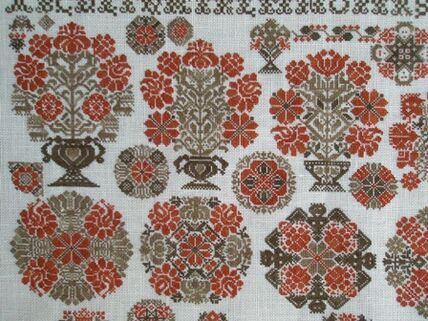
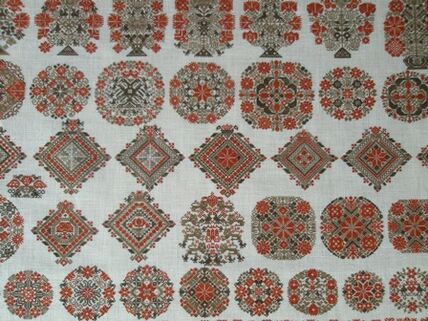

Flower pots, lions, angels, letters, crowns, trees of life, rosettes, lots of little birds and diamonds... A young girl gets a very large and very fine piece of linen, plenty of silk yarn and a fine needle. What happens? Does she not have fear of this piece pf EMPTINESS? Is a Vierlanden sampler created while she is working it? Where does she take the motifs from? Does she take the count of her piece of fabric before the motifs are placed? Does she design motifs, does she transform existing ones?
There are no paper needlework patterns the stitcher can use in the depots of museums or private collectors. So she must have gathered the embroidered motifs on aprons, sheets, curtains, pillows, pew cushions, garments in the parental home in order to capture them for her own collection in the sampler – for her own household in later years and for the numerous festivities.
Mette Putfarckens has chosen a great many and diverse selection of motifs and has made a note while stitching in incredible patience and untiring diligence.

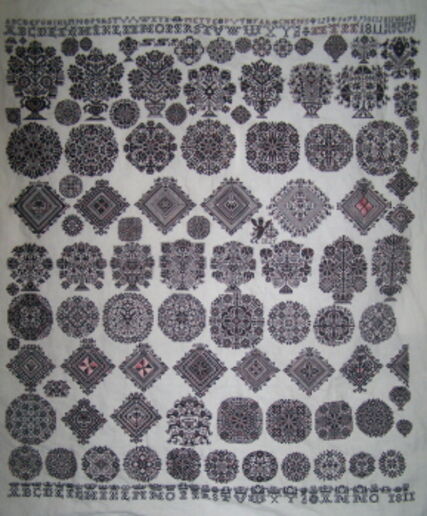
- trees of life and flower pots with birds, hearts, deer, stylized roses, carnations, tulips, lilies;
- rosettes with various flowers, stars, angels' heads and little birds;
- diamonds with trees, flowers and one with 32 birds;
- capitals adorned by a multitude of crowns.
There are motifs for every occasion concerning the family and with the former deeply rooted view of life of the Christian type:
- the tree as a symbol of God-given human life - passing through the annual cycle refers to life, death and resurrection, and the form of a stag's antlers reminds us of the tree of life, it is renewed annually;
- the dove as a significant symbolic animal, which was believed to have a peaceful and gentle character, and that makes her the paragon of love and gentleness; in the Bible the dove is the symbol of the end of the Flood; the “seven gifts of the Holy Spirit” (wisdom, understanding, counsel, fortitude, knowledge, piety and fear of the Lord) were represented by seven doves; newborns are embodied by doves and in the symbolism of the grave the dove is the “soul bird” that is descending to Paradise and sits there on the tree of life.
The political affiliation of the former Vierlanden to the municipal administration of the free imperial towns of Hamburg and Lübeck was integrated on this sampler in the form of arms of the double-headed eagle, the Hamburg gate and the lion.
Mette (in Northern Europe short for Margaret) began in 1811 and completed her sampler stitching only “181-”. In 1825, a “death angel” was placed between the motif rows with thick floss. Again, many questions remain!
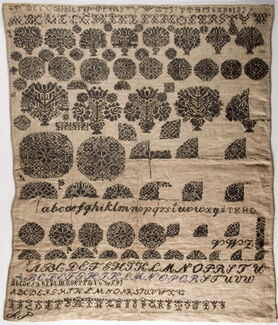
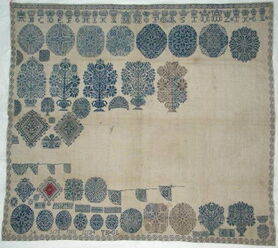
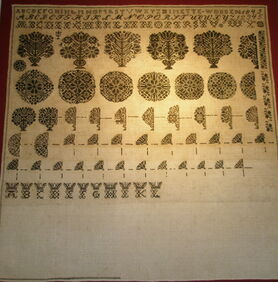
Mette's sampler is held by the Victoria & Albert Museum in London since 1940, it has the inventory number T 23-1940, size: approx. 61 cm in width and 66 cm in height and it is exhibited at the Textile Hall. Unfortunately, it could not be removed by the museum for a colour photograph.
Such a large, complete and harmonious -peaceful and yet exciting Vierlanden sampler (there is much to see on it!) is seldom, because many of these creations started later remained "UFOs", unfortunately. Therefore, rejoice with me in "METTE 1811/1825".
Crosses: 565 x 662
Size: 80 x 93,5 cm
Stitches: Cross stitch, satin stitch, back stitch